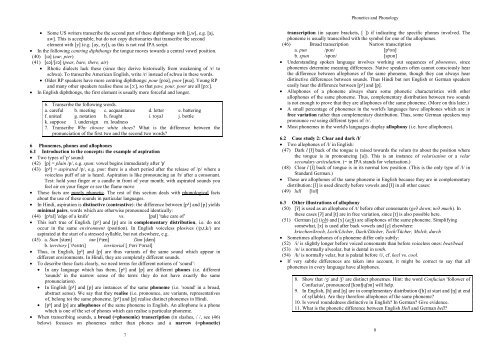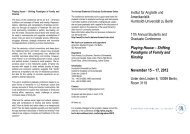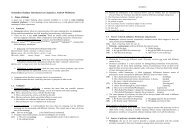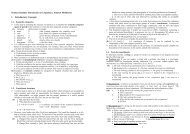Phonetics/Phonology - the Department of English and American ...
Phonetics/Phonology - the Department of English and American ...
Phonetics/Phonology - the Department of English and American ...
You also want an ePaper? Increase the reach of your titles
YUMPU automatically turns print PDFs into web optimized ePapers that Google loves.
<strong>Phonetics</strong> <strong>and</strong> <strong>Phonology</strong><br />
• Some US writers transcribe <strong>the</strong> second part <strong>of</strong> <strong>the</strong>se diphthongs with [j,w], e.g. [aj,<br />
aw]. This is acceptable, but do not copy dictionaries that transcribe <strong>the</strong> second<br />
element with [y] (e.g. [ay, ɔy]), as this is not real IPA script.<br />
• In <strong>the</strong> following centring diphthongs <strong>the</strong> tongue moves towards a central vowel position.<br />
(40) [ɪə] (ear, pier)<br />
(41) [eə]/[ɛə] (pear, bare, <strong>the</strong>re, air)<br />
• Rhotic dialects lack <strong>the</strong>se (since <strong>the</strong>y derive historically from weakening <strong>of</strong> /r/ to<br />
schwa). To transcribe <strong>American</strong> <strong>English</strong>, write /r/ instead <strong>of</strong> schwa in <strong>the</strong>se words.<br />
• Older RP speakers have more centring diphthongs: pour [pɔə], poor [puə]. Young RP<br />
<strong>and</strong> many o<strong>the</strong>r speakers realise <strong>the</strong>se as [ɔ:], so that paw, pour, poor are all [pɔ:].<br />
• In <strong>English</strong> diphthongs, <strong>the</strong> first element is usually more forceful <strong>and</strong> longer.<br />
6. Transcribe <strong>the</strong> following words.<br />
a. careful b. meeting c. acquaintance d. letter e. battering<br />
f. united g. notation h. fought i. royal j. bottle<br />
k. suppose l. undersign m. loudness<br />
7. Transcribe Why choose white shoes? What is <strong>the</strong> difference between <strong>the</strong><br />
pronunciation <strong>of</strong> <strong>the</strong> first two <strong>and</strong> <strong>the</strong> second two words?<br />
6 Phonemes, phones <strong>and</strong> allophones<br />
6.1 Introduction to <strong>the</strong> concepts: <strong>the</strong> example <strong>of</strong> aspiration<br />
• Two types <strong>of</strong> 'p' sound:<br />
(42) [p] = plain /p/, e.g. spun: vowel begins immediately after 'p'<br />
(43) [pʰ] = aspirated /p/, e.g. pun: <strong>the</strong>re is a short period after <strong>the</strong> release <strong>of</strong> /p/ where a<br />
voiceless puff <strong>of</strong> air is heard. Aspiration is like pronouncing an /h/ after a consonant.<br />
Test: hold your finger or a c<strong>and</strong>le in front <strong>of</strong> your mouth; with aspirated sounds you<br />
feel air on your finger or see <strong>the</strong> flame move<br />
• These facts are purely phonetic. The rest <strong>of</strong> this section deals with phonological facts<br />
about <strong>the</strong> use <strong>of</strong> <strong>the</strong>se sounds in particular languages.<br />
• In Hindi, aspiration is distinctive (contrastive): <strong>the</strong> difference between [pʰ] <strong>and</strong> [p] yields<br />
minimal pairs, words which are o<strong>the</strong>rwise pronounced identically:<br />
(44) [pʰal] 'edge <strong>of</strong> a knife' vs. [pal] 'take care <strong>of</strong>'<br />
• This isn't true <strong>of</strong> <strong>English</strong>. [pʰ] <strong>and</strong> [p] are in complementary distribution, i.e. do not<br />
occur in <strong>the</strong> same environment (position). In <strong>English</strong> voiceless plosives (/p,t,k/) are<br />
aspirated at <strong>the</strong> start <strong>of</strong> a stressed syllable, but not elsewhere, e.g.<br />
(45) a. Stan [stæn] tan [tʰæn] Dan [dæn]<br />
b. territory [ˈtʰerɪtrɪ] territorial [ˌtʰerɪˈtʰɔrɪəl]<br />
• Thus, in <strong>English</strong>, [pʰ] <strong>and</strong> [p] are thus variants <strong>of</strong> <strong>the</strong> same sound which appear in<br />
different environments. In Hindi, <strong>the</strong>y are completely different sounds.<br />
• To describe <strong>the</strong>se facts clearly, we need terms for different notions <strong>of</strong> ‘sound’:<br />
• In any language which has <strong>the</strong>m, [pʰ] <strong>and</strong> [p] are different phones (i.e. different<br />
'sounds' in <strong>the</strong> narrow sense <strong>of</strong> <strong>the</strong> term: <strong>the</strong>y do not have exactly <strong>the</strong> same<br />
pronunciation).<br />
• In <strong>English</strong> [pʰ] <strong>and</strong> [p] are instances <strong>of</strong> <strong>the</strong> same phoneme (i.e. 'sound' in a broad,<br />
abstract sense). We say that <strong>the</strong>y realise (i.e. pronounce, are variants, representatives<br />
<strong>of</strong>, belong to) <strong>the</strong> same phoneme. [pʰ] <strong>and</strong> [p] realise distinct phonemes in Hindi.<br />
• [pʰ] <strong>and</strong> [p] are allophones <strong>of</strong> <strong>the</strong> same phoneme in <strong>English</strong>. An allophone is a phone<br />
which is one <strong>of</strong> <strong>the</strong> set <strong>of</strong> phones which can realise a particular phoneme.<br />
• When transcribing sounds, a broad (=phonemic) transcription (in slashes, / /, see (46)<br />
below) focusses on phonemes ra<strong>the</strong>r than phones <strong>and</strong> a narrow (=phonetic)<br />
7<br />
transcription (in square brackets, [ ]) if indicating <strong>the</strong> specific phones involved. The<br />
phoneme is usually transcribed with <strong>the</strong> symbol for one <strong>of</strong> <strong>the</strong> allophones.<br />
(46) Broad transcription Narrow transcription<br />
a. pun /pʊn/ [pʰʊn]<br />
b. spun /spʊn/ [spʊn]<br />
• Underst<strong>and</strong>ing spoken language involves working out sequences <strong>of</strong> phonemes, since<br />
phonemes determine meaning differences. Native speakers <strong>of</strong>ten cannot consciously hear<br />
<strong>the</strong> difference between allophones <strong>of</strong> <strong>the</strong> same phoneme, though <strong>the</strong>y can always hear<br />
distinctive differences between sounds. Thus Hindi but not <strong>English</strong> or German speakers<br />
easily hear <strong>the</strong> difference between [pʰ] <strong>and</strong> [p].<br />
• Allophones <strong>of</strong> a phoneme always share some phonetic characteristics with o<strong>the</strong>r<br />
allophones <strong>of</strong> <strong>the</strong> same phoneme. Thus, complementary distribution between two sounds<br />
is not enough to prove that <strong>the</strong>y are allophones <strong>of</strong> <strong>the</strong> same phoneme. (More on this later.)<br />
• A small percentage <strong>of</strong> phonemes in <strong>the</strong> world's languages have allophones which are in<br />
free variation ra<strong>the</strong>r than complementary distribution. Thus, some German speakers may<br />
pronounce rot using different types <strong>of</strong> /r/.<br />
• Most phonemes in <strong>the</strong> world's languages display allophony (i.e. have allophones).<br />
6.2 Case study 2: Clear <strong>and</strong> dark /l/<br />
• Two allophones <strong>of</strong> /l/ in <strong>English</strong>:<br />
(47) Dark l [ɫ] back <strong>of</strong> <strong>the</strong> tongue is raised towards <strong>the</strong> velum (to about <strong>the</strong> position where<br />
<strong>the</strong> tongue is in pronouncing [u]). This is an instance <strong>of</strong> velarisation or a velar<br />
secondary articulation. (~ in IPA st<strong>and</strong>s for velarisation.)<br />
(48) Clear l [l] back <strong>of</strong> tongue is in its normal low position. (This is <strong>the</strong> only type <strong>of</strong> /l/ in<br />
St<strong>and</strong>ard German.)<br />
• These are allophones <strong>of</strong> <strong>the</strong> same phoneme in <strong>English</strong> because <strong>the</strong>y are in complementary<br />
distribution: [l] is used directly before vowels <strong>and</strong> [ɫ] in all o<strong>the</strong>r cases:<br />
(49) lull [lʊɫ]<br />
6.3 O<strong>the</strong>r illustrations <strong>of</strong> allophony<br />
(50) [ʔ] is used as an allophone <strong>of</strong> /t/ before o<strong>the</strong>r consonants (geʔ down; noʔ much). In<br />
<strong>the</strong>se cases [ʔ] <strong>and</strong> [t] are in free variation, since [t] is also possible here.<br />
(51) German [ç] (ich) <strong>and</strong> [x] (ach) are allophones <strong>of</strong> <strong>the</strong> same phoneme. Simplifying<br />
somewhat, [x] is used after back vowels <strong>and</strong> [ç] elsewhere:<br />
kriechen/kroch, Loch/Löcher, Dach/Dächer, Tuch/Tücher, Molch, durch<br />
• Sometimes allophones <strong>of</strong> a phoneme differ only subtly:<br />
(52) /i/ is slightly longer before voiced consonants than before voiceless ones: beat/bead<br />
(53) /n/ is normally alveolar, but is dental in tenth.<br />
(54) /k/ is normally velar, but is palatal before /i/, cf. keel vs. cool.<br />
• If very subtle differences are taken into account, it might be correct to say that all<br />
phonemes in every language have allophones.<br />
8. Show that /ʒ/ <strong>and</strong> /ʃ/ are distinct phonemes. Hint: <strong>the</strong> word Confucian 'follower <strong>of</strong><br />
Confucius', pronounced [kənfjuʃən] will help.<br />
9. In <strong>English</strong>, [h] <strong>and</strong> [ŋ] are in complementary distribution ([h] at start <strong>and</strong> [ŋ] at end<br />
<strong>of</strong> syllable). Are <strong>the</strong>y <strong>the</strong>refore allophones <strong>of</strong> <strong>the</strong> same phoneme?<br />
10. Is vowel roundedness distinctive in <strong>English</strong>? In German? Give evidence.<br />
11. What is <strong>the</strong> phonetic difference between <strong>English</strong> Hell <strong>and</strong> German hell?<br />
8







